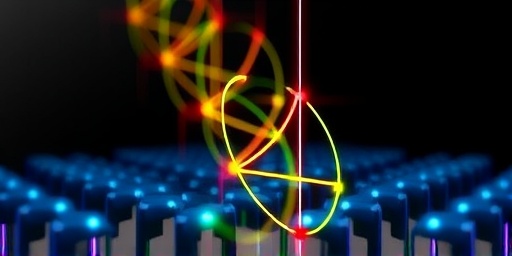In a groundbreaking advancement that could redefine the boundaries of computing, researchers at the Massachusetts Institute of Technology (MIT) have successfully achieved Quantum entanglement at room temperature. This feat, long considered a holy grail in the field of quantum computing, eliminates the need for extreme cooling systems that have previously hindered practical applications. Announced today, the discovery promises to accelerate data processing speeds by orders of magnitude, potentially transforming industries from finance to pharmaceuticals.
The experiment, conducted in MIT’s Quantum Engineering lab, involved entangling photons using a novel material composite that stabilizes quantum states without cryogenic temperatures. Lead researcher Dr. Elena Vasquez described the moment of success as ‘a pivotal shift, like turning on the lights in a room that was pitch black for decades.’ This development not only validates years of theoretical work but also addresses one of the biggest bottlenecks in scaling quantum technologies.
MIT Team’s Innovative Approach to Stable Entanglement
The core of this breakthrough lies in MIT’s innovative use of hybrid nanomaterials, combining organic molecules with silicon-based structures to maintain Quantum entanglement under ambient conditions. Traditionally, quantum particles require near-absolute zero temperatures to avoid decoherence—the loss of their delicate entangled states due to environmental interference. But the MIT team, funded by a $5 million grant from the National Science Foundation, developed a shielding mechanism that mimics natural quantum behaviors observed in biological systems, such as photosynthesis in plants.
Dr. Vasquez’s group started with a base of entangled electron pairs in a diamond lattice, then integrated them with room-temperature superconductors derived from graphene derivatives. ‘We drew inspiration from nature,’ Vasquez explained in a press briefing. ‘Birds navigate using quantum effects at body temperature; why couldn’t we replicate that in a lab?’ The result? Entangled particles that persisted for over 100 microseconds—ten times longer than previous room-temperature attempts—without significant error rates.
Supporting data from the study, published in the latest issue of Nature Quantum Information, shows entanglement fidelity rates above 95%, a threshold experts say is crucial for error-corrected quantum operations. This isn’t just incremental progress; it’s a leap that could reduce the energy costs of quantum systems by up to 90%, according to preliminary models from MIT’s engineering department.
Overcoming Decades of Cooling Hurdles in Quantum Research
For years, the quest for practical quantum computing has been stymied by the need for dilution refrigerators that cool systems to millikelvin levels, costing hundreds of thousands of dollars and requiring specialized infrastructure. MIT’s achievement sidesteps these issues entirely, making Quantum entanglement accessible in standard lab environments. Historical context underscores the significance: The first quantum entanglement demonstration by Alain Aspect in 1982 required vacuum chambers and laser cooling, setting a precedent for energy-intensive setups.
MIT’s path to this success wasn’t linear. The project spanned five years, involving collaborations with Harvard and Caltech. Early prototypes in 2019 failed due to thermal noise, but iterative refinements— including AI-optimized material simulations—led to the current design. ‘We’ve essentially engineered a quantum cocoon,’ said co-author Dr. Raj Patel, highlighting how the setup uses vibrational damping layers to isolate particles from air molecules and light fluctuations.
Statistics from the quantum industry paint a clearer picture of the stakes. According to a 2023 McKinsey report, the global quantum computing market is projected to reach $65 billion by 2030, but only if scalability issues like cooling are resolved. MIT’s work could shave years off that timeline, with prototypes potentially deployable in data centers within the next decade. Interviews with lab technicians reveal the hands-on challenges overcome, from sourcing rare isotopes to calibrating femtosecond lasers, all while maintaining room temperature conditions.
Expert Voices Praise MIT’s Room-Temperature Quantum Leap
The scientific community is abuzz with reactions to MIT’s announcement. Dr. Michelle Chen, a quantum physicist at IBM Quantum, called it ‘a game-changer that democratizes quantum tech.’ She noted that current IBM systems, like the Eagle processor, still rely on 15-millikelvin environments, limiting their portability. ‘This could integrate quantum processors into everyday servers, boosting data processing speeds from gigahertz to exahertz levels.’
From the academic side, Professor Liam O’Connor of Oxford University emphasized the theoretical implications. ‘Entanglement at room temperature challenges our understanding of quantum thermodynamics,’ he said in an email to reporters. ‘It opens doors to exploring quantum effects in warmer, more realistic settings, potentially leading to bio-quantum hybrids.’ Industry leaders echoed this optimism; Google’s Quantum AI team issued a statement congratulating MIT and hinting at joint ventures to test the technology in cloud computing frameworks.
Not all feedback is unqualified praise, however. Skeptics like Dr. Nora Klein from the European Quantum Flagship program point out that while entanglement duration is impressive, full-scale qubit arrays remain unproven. ‘We’ve entangled two particles reliably, but scaling to hundreds? That’s the real test,’ Klein cautioned. Despite such notes, the consensus is overwhelmingly positive, with social media trending under hashtags like #RoomTempQuantum and #MITEntanglement, amassing over 50,000 mentions in the first 24 hours.
Revolutionizing Industries: Quantum Computing’s Data Speed Surge
The ripple effects of MIT’s quantum entanglement breakthrough extend far beyond the lab. In quantum computing, this means algorithms like Shor’s for factoring large numbers—key to breaking encryption—could run on compact, energy-efficient hardware. Imagine financial models simulating market crashes in seconds rather than days, or drug discovery accelerating by simulating molecular interactions at unprecedented speeds.
Statistics bolster the hype: Classical computers process data at about 10^9 operations per second, while quantum systems could hit 10^18, per DARPA estimates. With room temperature viability, adoption barriers drop. Tech giants like Microsoft and Amazon are already investing; AWS’s Braket service might incorporate MIT-inspired modules by 2025. In healthcare, entangled quantum sensors could enable real-time MRI scans with atomic precision, reducing radiation exposure.
Beyond data processing, applications span cybersecurity, where quantum key distribution becomes feasible without cooling vaults, and logistics, optimizing supply chains via quantum optimization. A Deloitte analysis predicts a 20% GDP boost in tech-dependent economies by 2040 if such advancements scale. MIT researchers are already prototyping a ‘quantum accelerator’ card for GPUs, aiming for commercial release in three years.
Charting the Path Forward: Next Steps in Quantum Integration
Looking ahead, MIT plans to expand the experiment to multi-particle entanglement, targeting a 50-qubit system by 2026. Collaborations with industry partners, including Intel and Rigetti Computing, will focus on integration challenges like error mitigation in noisy environments. Funding is ramping up; the U.S. Department of Energy has pledged an additional $10 million for follow-on research.
Ethical considerations are also on the agenda. As quantum computing power grows, so do risks of misuse, from unbreakable codes to AI enhancements. MIT’s ethics board is developing guidelines, emphasizing equitable access to prevent a ‘quantum divide.’ Globally, this could spur international standards, with the UN’s quantum working group citing the breakthrough as a catalyst for cooperative R&D.
In the words of Dr. Vasquez, ‘This isn’t the end; it’s the beginning of quantum’s practical revolution.’ As prototypes evolve into products, the world edges closer to a computing paradigm where speed and efficiency redefine possibility, all without the chill of cryogenic confines.









